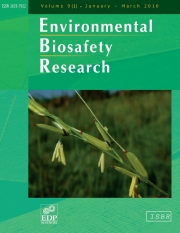Article contents
Stability of Cry1Ab protein during long-term storage for standardization of insect bioassays
Published online by Cambridge University Press: 22 October 2009
Abstract
The reliable use of purified Cry1Ab protein standards is a prerequisite for ecological studies and resistance monitoring programs of Cry1Ab-expressing transgenic corn. In this study the stability and activity of different Cry1Ab protein batches expressed in and purified from Escherichia coli were determined during two-year storage at different temperature conditions (4 °C, –20 °C, and –80 °C). SDS-Polyacrylamide gel electrophoresis showed degradation of the protein stored at 4 °C over four months, whereas no difference in the band intensity of the Cry1Ab proteins stored at –20 °C and –80 °C was observed. Bioassays with neonate larvae of Ostrinianubilalis indicated that the biological activity of Cry1Ab varied from batch to batch, depending on the production process. Cry1Ab protein stored at 4 °C for four months showed a significantly decreasing activity measured as median lethal concentration (LC50), whereas the protein activity declined less than 11-fold after two years storage at –20 °C. When stored at –80 °C the toxin activity remained relatively stable for at least 30 months, as indicated by low LC50 values of 7–10 ng Cry1Ab per cm2 diet. These experiments demonstrate that appropriate long-term storage conditions of Cry1Ab protein standards are crucial for resistance monitoring programs of Bt corn, and storage at –80 °C is recommended.
- Type
- Research Article
- Information
- Copyright
- © ISBR, EDP Sciences, 2009
References
- 11
- Cited by


